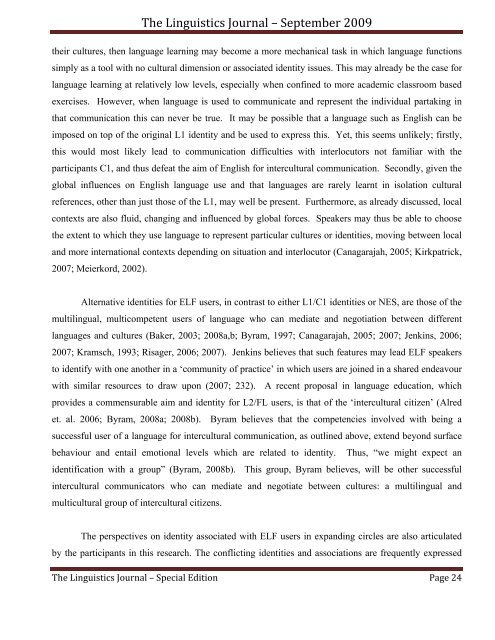The Linguistics Journal September 2009 Special Edition Language
The Linguistics Journal September 2009 Special Edition Language
The Linguistics Journal September 2009 Special Edition Language
Create successful ePaper yourself
Turn your PDF publications into a flip-book with our unique Google optimized e-Paper software.
<strong>The</strong> <strong>Linguistics</strong> <strong>Journal</strong> – <strong>September</strong> <strong>2009</strong><br />
their cultures, then language learning may become a more mechanical task in which language functions<br />
simply as a tool with no cultural dimension or associated identity issues. This may already be the case for<br />
language learning at relatively low levels, especially when confined to more academic classroom based<br />
exercises. However, when language is used to communicate and represent the individual partaking in<br />
that communication this can never be true. It may be possible that a language such as English can be<br />
imposed on top of the original L1 identity and be used to express this. Yet, this seems unlikely; firstly,<br />
this would most likely lead to communication difficulties with interlocutors not familiar with the<br />
participants C1, and thus defeat the aim of English for intercultural communication. Secondly, given the<br />
global influences on English language use and that languages are rarely learnt in isolation cultural<br />
references, other than just those of the L1, may well be present. Furthermore, as already discussed, local<br />
contexts are also fluid, changing and influenced by global forces. Speakers may thus be able to choose<br />
the extent to which they use language to represent particular cultures or identities, moving between local<br />
and more international contexts depending on situation and interlocutor (Canagarajah, 2005; Kirkpatrick,<br />
2007; Meierkord, 2002).<br />
Alternative identities for ELF users, in contrast to either L1/C1 identities or NES, are those of the<br />
multilingual, multicompetent users of language who can mediate and negotiation between different<br />
languages and cultures (Baker, 2003; 2008a,b; Byram, 1997; Canagarajah, 2005; 2007; Jenkins, 2006;<br />
2007; Kramsch, 1993; Risager, 2006; 2007). Jenkins believes that such features may lead ELF speakers<br />
to identify with one another in a ‘community of practice’ in which users are joined in a shared endeavour<br />
with similar resources to draw upon (2007; 232). A recent proposal in language education, which<br />
provides a commensurable aim and identity for L2/FL users, is that of the ‘intercultural citizen’ (Alred<br />
et. al. 2006; Byram, 2008a; 2008b). Byram believes that the competencies involved with being a<br />
successful user of a language for intercultural communication, as outlined above, extend beyond surface<br />
behaviour and entail emotional levels which are related to identity. Thus, “we might expect an<br />
identification with a group” (Byram, 2008b). This group, Byram believes, will be other successful<br />
intercultural communicators who can mediate and negotiate between cultures: a multilingual and<br />
multicultural group of intercultural citizens.<br />
<strong>The</strong> perspectives on identity associated with ELF users in expanding circles are also articulated<br />
by the participants in this research. <strong>The</strong> conflicting identities and associations are frequently expressed<br />
<strong>The</strong> <strong>Linguistics</strong> <strong>Journal</strong> – <strong>Special</strong> <strong>Edition</strong> Page 24


